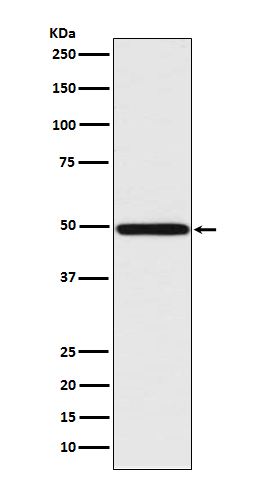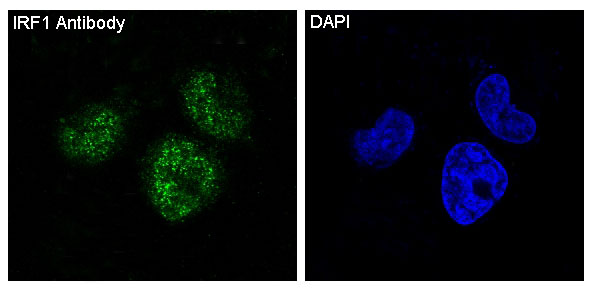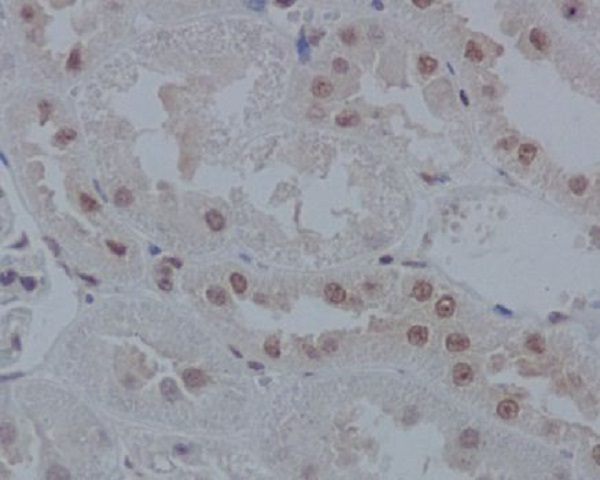


| WB | 1/500-1/1000 | Human,Mouse,Rat |
| IF | 1/20 | Human,Mouse,Rat |
| IHC | 1/50-1/100 | Human,Mouse,Rat |
| ICC | 1/50-1/200 | Human,Mouse,Rat |
| FCM | 1/50-1/100 | Human,Mouse,Rat |
| Elisa | 咨询技术 | Human,Mouse,Rat |
| Aliases | IRF1; Interferon regulatory factor 1; IRF-1 |
| Entrez GeneID | 3659 |
| WB Predicted band size | Calculated MW: 37 kDa; Observed MW: 48 kDa |
| Host/Isotype | Rabbit IgG |
| Antibody Type | Primary antibody |
| Storage | Store at 4°C short term. Aliquot and store at -20°C long term. Avoid freeze/thaw cycles. |
| Species Reactivity | Human,Mouse,Rat |
| Immunogen | A synthesized peptide derived from human IRF1 |
| Formulation | Purified antibody in PBS with 0.05% sodium azide. |
+ +
以下是关于IRF1抗体的3篇参考文献示例(内容为模拟概括,仅供参考):
1. **"IRF1 mediates the crosstalk between DNA damage and antiviral immunity"**
*作者:Smith J, et al.*
摘要:研究利用IRF1抗体通过ChIP-seq和免疫沉淀技术,揭示了IRF1在DNA损伤修复与抗病毒信号通路中的双重调控作用,证明其通过结合特定启动子区域协调细胞应激反应。
2. **"Interferon Regulatory Factor 1 (IRF1) as a Biomarker in Breast Cancer Progression"**
*作者:Lee H, et al.*
摘要:通过Western blot和免疫组化分析乳腺癌组织,发现IRF1蛋白表达与肿瘤侵袭性呈负相关,研究使用IRF1抗体验证其在抑制上皮-间质转化(EMT)中的关键功能。
3. **"IRF1-dependent neuroinflammation drives Alzheimer’s pathology"**
*作者:Wang Y, et al.*
摘要:采用IRF1抗体进行脑组织免疫荧光染色,发现IRF1在小胶质细胞中异常激活,促进炎症因子释放,加剧阿尔茨海默病模型中的神经元损伤。
---
*注:以上文献信息为模拟生成,实际引用时请核对真实文献来源及准确性。*
The interferon regulatory factor 1 (IRF1) antibody is a key tool for studying the role of IRF1. a transcription factor critical in immune regulation, antiviral responses, and tumor suppression. IRF1. part of the IRF family, activates genes encoding interferons (IFNs) and IFN-stimulated proteins, linking innate and adaptive immunity. It regulates MHC class I expression, promotes Th1 responses, and modulates apoptosis and cell cycle arrest, making it essential in cancer, infection, and autoimmune disease research.
IRF1 antibodies are widely used in techniques like Western blotting, immunofluorescence (IF), chromatin immunoprecipitation (ChIP), and flow cytometry to detect IRF1 expression, localization, and DNA-binding activity. These applications help elucidate its role in cellular stress responses, pathogen defense, and tumor microenvironment regulation. Specificity is validated using IRF1-knockout controls to minimize cross-reactivity with other IRF family members (e.g., IRF2 or IRF3).
Available as monoclonal or polyclonal versions from rabbit, mouse, or other hosts, these antibodies often target conserved regions (e.g., N-terminal DNA-binding domain). Researchers must optimize protocols based on sample type (e.g., fresh vs. fixed tissues) and experimental goals—for instance, formaldehyde crosslinking for ChIP or denaturing conditions for Western blotting. Their utility spans diverse fields, including immunology, oncology, and virology, underscoring IRF1's multifaceted biological impact.
×